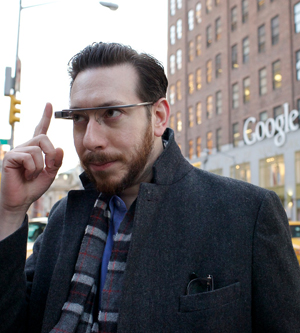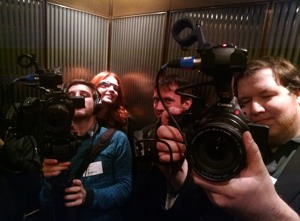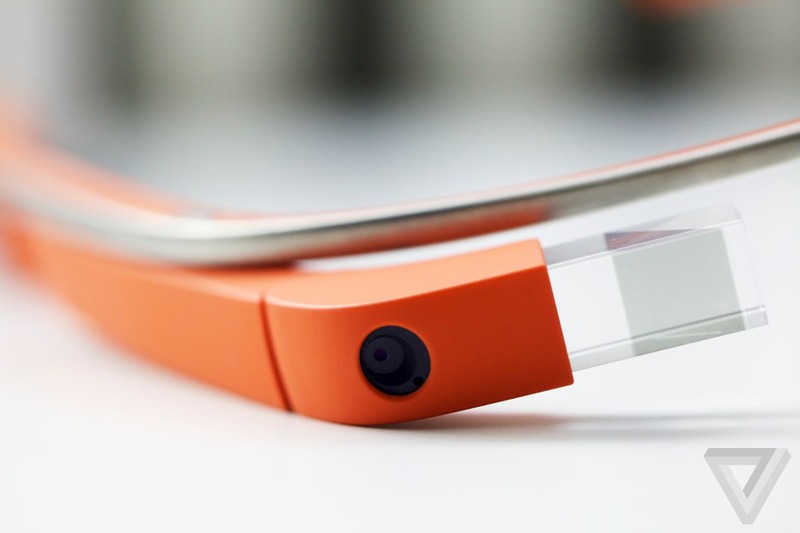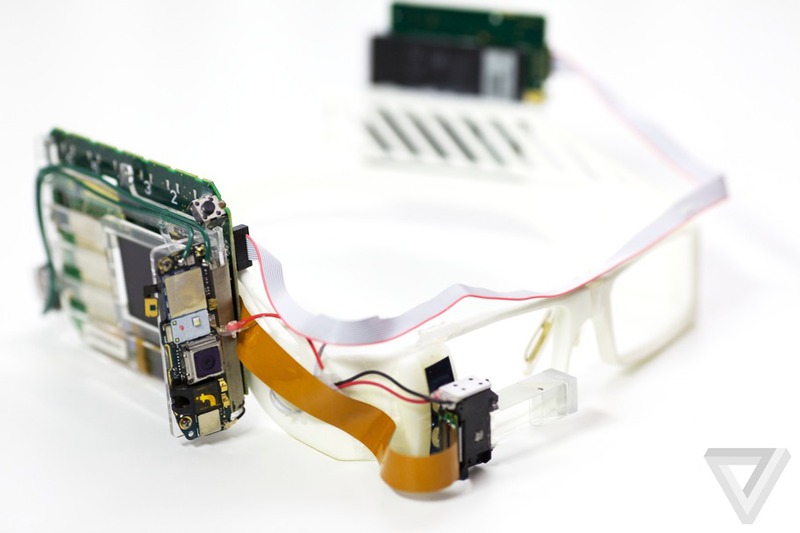How I used Google Glass: the future, but with monthly updates (part 2)
- Transfer
I removed the previous post in draft copies, because I forgot to design it as a translation. Sorry for the inconvenience.
First part

Finally, I got a chance to put on the device to feel on myself what it feels like to use Glasses. I have been waiting for this moment all day. And then he came.
When you activate Points, you should notice a small screen that hovers in the upper right corner of your field of view, but I do not see it completely. Instead, I observe the ghost of its upper part, and the lower one has generally gone somewhere beyond the line of sight.
Steve and Isabelle straighten their nose mount, and finally I see a luminous square. Victory.
It takes some time to get used to the screen soaring in front of you, and this is especially unusual when it appears and then disappears, you want to call it again, but don’t know how. Fortunately, this happened to me only once.
And here is what you see: the clock, under them - a short text - “ok glass”. So you can activate Points with your voice. In fact, this process consists of 2 steps. First you need to touch the temple of the glasses (which are actually sensory) or slowly tilt your head back - a gesture that wakes the Glasses. Once you have done this, you can execute the commands by saying “ok glass”, and then select the desired action by scrolling your finger along the temple of glasses. You can do this by moving your finger forward or backward along the strip, choose - by touching, returning - by swiping your finger from top to bottom. However, the main interaction is voice.
The device can receive data using the built-in Wi-Fi module or Bluetooth, connecting to your Android device or iPhone in order to use its 3G or 4G connection. The glasses themselves do not have a cellular module, but there is GPS.
To begin with, its use almost completely coincides with what the company showed in the last commercial. There are no special effects - that's exactly how Glasses are used. Simple, elegant, without interfering with the review. The screen is unobtrusive, it does not distract you. Here he just was - and now he is gone. He is not shocking. Not shaking. This is just a new object in your field of vision. And it is very cool.


Photos taken by Google Glass
Glasses do all kinds of things after you say ok glass. All those things that you would like to do with the camera on your face. “Take a picture” - takes a photo. “Record a video” - records a ten-second video. If you need more, just touch the temple. Say “ok glass, Google” and a search engine will open, integrated into something resembling Google Now and the Knowledge Graph. Basically, when you ask Points to questions, you get an answer in the form of stylized cards with information - like in Google Now on Android.
Natural language searches work in most cases. But when not, it discourages, leaving you with a completely useless result. Also, Glasses do not always understand you correctly or the pace of speech expected from you does not coincide with the real one. Of all these, I fought with Glasses, giving voice commands that, it seemed, the device did not manage to interpret. If I managed to give them “correctly”, the Points usually reacted quickly, giving out the right information and entering the right state.
The cause of some problems is the banal lack of communication. The presence of a good channel, obviously, is a prerequisite for the normal functioning of the device. When you take your Points for a walk, a signal loss or an overly slow connection makes the device almost useless.
Steve and Isabelle know that things are not going smoothly. In fact, they told me that the team plans to release monthly updates for the devices when Explorer is gaining momentum. There is still a lot of work ahead.
But the most interesting part for most people is not the search functionality, at least not in the usual form. Yes, Points can tell how old Brad Pitt is (49, for those who keep score), but Google is more interested in providing you with the information you need at this particular moment. Do you want the weather? You are welcome. Interested in how you get to the right place? They can do this, too, in real time, from turn to turn. Want to share your experiences with someone on Google Hangout? Yes, it is also possible.

But the thing that makes everyone crazy, and which you most likely would like to see, is the ability to take photos and videos “in the first person”. I won’t lie if I say that it is surprisingly convenient (and a little frightening) - to be able to start recording or take a photo with a couple of finger swings or a simple voice command.
During my testing of Points, we decided to get directions to the nearest Starbucks - the film crew also came with us. As soon as we went inside, the workers asked to stop filming. Sure, no problem. But Glasses kept recording all the time while I was making an order. Of course, you can see the light in the prism when the device is recording, but it seemed to me that most people have no idea what is in front of them. The cashier, it seems, still did not dare to ask me what it was wearing on my face, but never asked. And he certainly didn’t ask me to stop recording.
As soon as Explorer versions spread around the world, there will likely be a lot of abuse in this area. Perhaps “abuse” is the right word. Steve says that one of the tasks of the Explorer program is to understand how people want (and will) use Glasses. “This is very important,” he says, “what we are trying to do is expand the circle of users of the Points. Currently, it consists of our team and several other people from Google who test them. We want to expand this group beyond Google. We believe that this is really important for the development of Points, because this is a whole new product, and not just some kind of software. We want to understand how it will fit into people's lives. ” That is his opinion. “This is a very personal device. We would like to better understand how other people are going to use it. We think,
I asked them if it was their attempt to define a certain “etiquette of using Points”. Will there be an analogue of retweets for Points? “That's what Explorer is for,” says Steve. But she will not answer the question of what is right to do and what is not with the camera, which does not need to be held in order to take a photo and is often invisible to others. Will people feel comfortable thinking about it? What are they going to do about it?
Privacy will be a big hurdle for Google with Points. As great as the need to convince ordinary people to wear something alien and not fashionable, which are currently Points.

But still, what is it like to wear Glasses? Use them while walking? This is awesome!
Imagine this: you received a message or a call while you are walking along a busy street, in this situation you need to do 2 or 3 things. Most of them require a complete distraction from what you are doing now. With Points, this information simply appears before you, in your field of vision, waiting for your actions. And these actions - just to touch in the temple or raise your head - nothing that can distract you from the main occupation - maneuvering between people.
This is a simple concept that is very strong in practice.
Same thing with navigation. When I arrive in New York, I have to constantly open Google Maps to understand where I ended up. Even after a dozen years in the city, I think I will never be able to find the right turn for exiting the subway. You still need to work hard, asking Points to get directions, but the disappearance of the barrier in the form of an annoying device in your hands matters, and the display of routes in real time is even more so. In the city, Glasses make you feel more powerful, equipped and less distracted.
Admittedly, wearing the Glasses made me awkward, or maybe it's just my paranoia (or the fact that I look like a big eccentric), but I felt that people were staring at me. Everyone with whom I met the gaze seemed to look and say “hey, what kind of garbage is this?”, And this caused a feeling of awkwardness.
Steve argues that when such questions are nevertheless asked, people become interested in Points. “We wore them in public for almost a year and it was very interesting and exciting. At first, we were happy and confident in the design, but you never know for sure until you start wearing them everywhere. Of course, my friends make fun of me: "no girl will speak to you now, they think you're strange." But exactly the opposite happens. ”
I do not think that Points will be appropriate in any situation. It's easy to imagine how great it is for parents to take off all these delightful things their children do, or skydivers and climbers who want to capture their experience, despite their busy hands. And they are likely to be useful in Thailand to get directions or translate something - but they may not be appropriate at a dinner party, or on a date, or while watching a movie. In fact, they can make these situations awkward and even lead to unpleasant consequences.
Sometimes you want to distract yourself in the old-fashioned way. And sometimes you want people to see you, not the device on your face. Which, perhaps, removes you right now, and maybe does not remove you.
This brings me back to the original question: who wants to wear this in public?

In truth, I started to love Glasses when I wore them. They are quite convenient and bring something new to your horizons (literally and figuratively), which is of great importance and potential. I don’t think that my face looks absolutely right without my usual glasses, and I also don’t think that it looks right with the Glasses, but after a while I began to feel this “irregularity” less and less. Already something, right?
The Sunglasses for the Glasses supplied with the device must go a long way to make the Glasses familiar. Collaborating with someone like Ray-Ban or Warby Parker will help them with this. It is possible to understand now, taking advantage of them and feeling how it feels to walk in Glasses in public; how comfortable you can be with this device.
Are they really for everyone? Not really. Does the team still need to go a long way to make them suitable for daily use? Definitely.
But I left with the conviction that this is not just another Google jerk. The more I used Glasses, the more they made sense to me, the more I wanted them. If the team invited me to sign up to have my current points, but supplemented by the technology of Points, I would sign and give the money at the same time. And this is the important thing that determines the niche of devices - for geeks or everyone wants to have one.
After hours with the Glasses, I decided that the main question is no longer “if?”, But “when?”.
First part
Topolsky in the looking glass

Finally, I got a chance to put on the device to feel on myself what it feels like to use Glasses. I have been waiting for this moment all day. And then he came.
When you activate Points, you should notice a small screen that hovers in the upper right corner of your field of view, but I do not see it completely. Instead, I observe the ghost of its upper part, and the lower one has generally gone somewhere beyond the line of sight.
Steve and Isabelle straighten their nose mount, and finally I see a luminous square. Victory.
It takes some time to get used to the screen soaring in front of you, and this is especially unusual when it appears and then disappears, you want to call it again, but don’t know how. Fortunately, this happened to me only once.
And here is what you see: the clock, under them - a short text - “ok glass”. So you can activate Points with your voice. In fact, this process consists of 2 steps. First you need to touch the temple of the glasses (which are actually sensory) or slowly tilt your head back - a gesture that wakes the Glasses. Once you have done this, you can execute the commands by saying “ok glass”, and then select the desired action by scrolling your finger along the temple of glasses. You can do this by moving your finger forward or backward along the strip, choose - by touching, returning - by swiping your finger from top to bottom. However, the main interaction is voice.
The device can receive data using the built-in Wi-Fi module or Bluetooth, connecting to your Android device or iPhone in order to use its 3G or 4G connection. The glasses themselves do not have a cellular module, but there is GPS.
To begin with, its use almost completely coincides with what the company showed in the last commercial. There are no special effects - that's exactly how Glasses are used. Simple, elegant, without interfering with the review. The screen is unobtrusive, it does not distract you. Here he just was - and now he is gone. He is not shocking. Not shaking. This is just a new object in your field of vision. And it is very cool.


Photos taken by Google Glass
Glasses do all kinds of things after you say ok glass. All those things that you would like to do with the camera on your face. “Take a picture” - takes a photo. “Record a video” - records a ten-second video. If you need more, just touch the temple. Say “ok glass, Google” and a search engine will open, integrated into something resembling Google Now and the Knowledge Graph. Basically, when you ask Points to questions, you get an answer in the form of stylized cards with information - like in Google Now on Android.
Natural language searches work in most cases. But when not, it discourages, leaving you with a completely useless result. Also, Glasses do not always understand you correctly or the pace of speech expected from you does not coincide with the real one. Of all these, I fought with Glasses, giving voice commands that, it seemed, the device did not manage to interpret. If I managed to give them “correctly”, the Points usually reacted quickly, giving out the right information and entering the right state.
The cause of some problems is the banal lack of communication. The presence of a good channel, obviously, is a prerequisite for the normal functioning of the device. When you take your Points for a walk, a signal loss or an overly slow connection makes the device almost useless.
Steve and Isabelle know that things are not going smoothly. In fact, they told me that the team plans to release monthly updates for the devices when Explorer is gaining momentum. There is still a lot of work ahead.
But the most interesting part for most people is not the search functionality, at least not in the usual form. Yes, Points can tell how old Brad Pitt is (49, for those who keep score), but Google is more interested in providing you with the information you need at this particular moment. Do you want the weather? You are welcome. Interested in how you get to the right place? They can do this, too, in real time, from turn to turn. Want to share your experiences with someone on Google Hangout? Yes, it is also possible.

But the thing that makes everyone crazy, and which you most likely would like to see, is the ability to take photos and videos “in the first person”. I won’t lie if I say that it is surprisingly convenient (and a little frightening) - to be able to start recording or take a photo with a couple of finger swings or a simple voice command.
During my testing of Points, we decided to get directions to the nearest Starbucks - the film crew also came with us. As soon as we went inside, the workers asked to stop filming. Sure, no problem. But Glasses kept recording all the time while I was making an order. Of course, you can see the light in the prism when the device is recording, but it seemed to me that most people have no idea what is in front of them. The cashier, it seems, still did not dare to ask me what it was wearing on my face, but never asked. And he certainly didn’t ask me to stop recording.
As soon as Explorer versions spread around the world, there will likely be a lot of abuse in this area. Perhaps “abuse” is the right word. Steve says that one of the tasks of the Explorer program is to understand how people want (and will) use Glasses. “This is very important,” he says, “what we are trying to do is expand the circle of users of the Points. Currently, it consists of our team and several other people from Google who test them. We want to expand this group beyond Google. We believe that this is really important for the development of Points, because this is a whole new product, and not just some kind of software. We want to understand how it will fit into people's lives. ” That is his opinion. “This is a very personal device. We would like to better understand how other people are going to use it. We think,
I asked them if it was their attempt to define a certain “etiquette of using Points”. Will there be an analogue of retweets for Points? “That's what Explorer is for,” says Steve. But she will not answer the question of what is right to do and what is not with the camera, which does not need to be held in order to take a photo and is often invisible to others. Will people feel comfortable thinking about it? What are they going to do about it?
Privacy will be a big hurdle for Google with Points. As great as the need to convince ordinary people to wear something alien and not fashionable, which are currently Points.

But still, what is it like to wear Glasses? Use them while walking? This is awesome!
Imagine this: you received a message or a call while you are walking along a busy street, in this situation you need to do 2 or 3 things. Most of them require a complete distraction from what you are doing now. With Points, this information simply appears before you, in your field of vision, waiting for your actions. And these actions - just to touch in the temple or raise your head - nothing that can distract you from the main occupation - maneuvering between people.
This is a simple concept that is very strong in practice.
Same thing with navigation. When I arrive in New York, I have to constantly open Google Maps to understand where I ended up. Even after a dozen years in the city, I think I will never be able to find the right turn for exiting the subway. You still need to work hard, asking Points to get directions, but the disappearance of the barrier in the form of an annoying device in your hands matters, and the display of routes in real time is even more so. In the city, Glasses make you feel more powerful, equipped and less distracted.
Admittedly, wearing the Glasses made me awkward, or maybe it's just my paranoia (or the fact that I look like a big eccentric), but I felt that people were staring at me. Everyone with whom I met the gaze seemed to look and say “hey, what kind of garbage is this?”, And this caused a feeling of awkwardness.
Steve argues that when such questions are nevertheless asked, people become interested in Points. “We wore them in public for almost a year and it was very interesting and exciting. At first, we were happy and confident in the design, but you never know for sure until you start wearing them everywhere. Of course, my friends make fun of me: "no girl will speak to you now, they think you're strange." But exactly the opposite happens. ”
I do not think that Points will be appropriate in any situation. It's easy to imagine how great it is for parents to take off all these delightful things their children do, or skydivers and climbers who want to capture their experience, despite their busy hands. And they are likely to be useful in Thailand to get directions or translate something - but they may not be appropriate at a dinner party, or on a date, or while watching a movie. In fact, they can make these situations awkward and even lead to unpleasant consequences.
Sometimes you want to distract yourself in the old-fashioned way. And sometimes you want people to see you, not the device on your face. Which, perhaps, removes you right now, and maybe does not remove you.
This brings me back to the original question: who wants to wear this in public?

Not “if,” but “when”
In truth, I started to love Glasses when I wore them. They are quite convenient and bring something new to your horizons (literally and figuratively), which is of great importance and potential. I don’t think that my face looks absolutely right without my usual glasses, and I also don’t think that it looks right with the Glasses, but after a while I began to feel this “irregularity” less and less. Already something, right?
The Sunglasses for the Glasses supplied with the device must go a long way to make the Glasses familiar. Collaborating with someone like Ray-Ban or Warby Parker will help them with this. It is possible to understand now, taking advantage of them and feeling how it feels to walk in Glasses in public; how comfortable you can be with this device.
Are they really for everyone? Not really. Does the team still need to go a long way to make them suitable for daily use? Definitely.
But I left with the conviction that this is not just another Google jerk. The more I used Glasses, the more they made sense to me, the more I wanted them. If the team invited me to sign up to have my current points, but supplemented by the technology of Points, I would sign and give the money at the same time. And this is the important thing that determines the niche of devices - for geeks or everyone wants to have one.
After hours with the Glasses, I decided that the main question is no longer “if?”, But “when?”.
